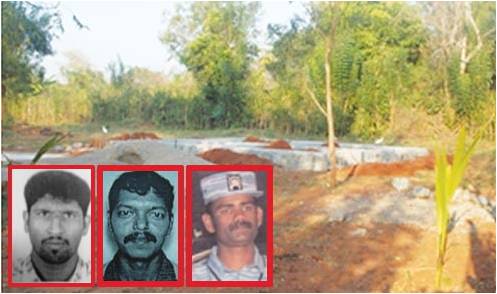
Sunday 20th April 2014
By Camelia Nathaniel

This land was bought by the LTTE to build a safe house, Selvanayagam Kajeepan
alias Gopi, Navaratnam Navaneethan alias Appan and Thaveyan
Although the LTTE was defeated almost five years ago, the rump of the LTTE has yet not given up their aim of dividing the country. This was evident by the recent incidents that took place in the North involving several terrorists both from here and abroad. According to intelligence sources, had these terrorists been successful in their attempt, the country could have plunged back into chaos.
Thanks to the efforts of the Terrorist Investigations Department (TID) and the military, their sinister plans were thwarted.
According to military sources, an attempt for the resurgence of terrorism in Sri Lanka surfaced in the general area of Pallai in the Jaffna Peninsula calling for launching of another phase of the LTTE struggle for a separate state. The information on several key suspects who were leading the campaign for resurgence of the LTTE also surfaced. Subsequent to investigations, the authorities made several arrests that led to the recovery of arms, ammunitions, explosives and other material that were in their possession.
Military sources also revealed that this local group was functioning under the instructions of LTTE leaders Nediyawan and Vinayagam who are based in Europe. They were preparing the ground for another armed struggle, claimed the military, and the immediate objectives of the local group included the recovery or war like material dumped by the LTTE during their retreat. The re-establishment of LTTE intelligence network, regrouping of the potential cadre including those rehabilitated, collecting information on potential targets including in other provinces, were the agenda of this group.
Investigations revealed that the funds for these activities that came from Europe were being transferred using the Hawala system which is an illegal system for money transfer widely used in the subcontinent. It was also revealed that many safe houses, vehicles and other resources required for resurgence of the LTTE had been procured by them using this money.
Three local leaders in the attempted resurgence of the LTTE were identified as Sundaralingam Kajeepan alias Thevihan (who was involved in aerial attacks on Anuradhapura Air Base and Kollonnawa Petroleum Storage in 2007), Selvanayagam Kajeepan alias Gobi, and Navarathnam Navaneethan alias Appan.
Taken into custody
Investigators trailing these local leaders made several arrests of second and third tier cadre. In one attempt on March 13, 2014, one of the suspected leaders known as Gobi escaped after shooting a police officer when they had tried to arrest him from a house in the North. With the escape of Gobi, several political parties in the North expressed concern that the whole Gobi episode was staged by the military and the government in order to conduct military operations in the North. According to intelligence sources, during investigations, information surfaced about Gobi and also about a character named Santhosam Master and funding from Switzerland. It has been revealed that it was Santhosam Master who had funded a poster campaign in the North carried out by Gobi, calling on the Tamils to rally together.
The TID had taken into custody 62 persons including 15 primary suspects who had assisted or been part of this plot. Although this group, headed by Gobi, had commenced their activities with a political face, it was an effort to regroup the LTTE cadres and reorganise themselves.
The TID sleuths had, through their investigations, discovered an elaborate plan by this group headed by Gobi to monitor several key positions in Colombo in order to conduct reconnaissance on key political figures.
With the recovery of weapons hidden by the terrorists in the North, it was also revealed that this group had stolen five mine detectors from the demining group ‘Dash’ to assist in their recovery mission. It was further confirmed that three of these were the mine detectors reported lost by this demining team in the house of Jeyakumari, who is believed to have assisted the group headed by Gobi, Appan and Thevihan. The serial numbers of the reportedly stolen mine detectors match those found at the house of Jeyakumari.
Gobi the lorry driver
The TID investigations had also revealed that Gobi had operated as a lorry driver in order to carry out surveillance operations in Colombo undetected by the law enforcement authorities. A bakery in the Dehiwela area named ‘Everyday’ was used by LTTE operatives under the instructions and supervision of Gobi and his group to monitor the VIP movements plying over the Dehiwala overhead bridge. Investigations are still underway to determine if any particular VIP was being targeted. A man by the name of Thambiah Bavanandan was put in charge of the bakery in Dehiwala to head the surveillance team.
According to TID sources they had also recovered a mobile phone in the possession of one of the occupants of the bakery in Dehiwala who was acting as an informant, photograpgs taken of the bridge and VIP movements.
Had their plan gone ahead without detection, one can only imagine what could have happened if this group had been successful in perhaps carrying out an assassination on a VIP.
It is not known exactly for how long this reconnaisance operation had been in place but thanks to the actions and surveilance and commitment of the TID and the military, a major catastrophy has been averted.
Meanwhile further inspired by the detection of the LTTE operatives in Dehiwala, the TID further carried on their investigations with greater commitment, in the North as well. During their investigations and search operations the TID and the military had been able to recover around five locations where arms and ammunition had been buried by the LTTE to be taken for later use.
It is also believed that Gobi had in his possession a map indicating the various exact locations that the buried caches of arms and ammunition had been placed. However perhaps due to the changing landskape in the \north due to the development activities in the |North they would have found it difficult to pin point the exact locations of the buried arms caches.
It has been revealed that Gobi had summoned an expert on GPS technology in Killinochchi in order to obtain his assistance in tracing the remaining caches of weapons hidden underground.
While Gobi was initially identified by the intelligence sleuths, Appan was later identified and then Thevian. Thevian had contacted a couple living in Vavuniya who are un-rehabilitated LTTE cadres and it was revealed that he had given them money to purchase a land in return for information provided to them. Thevian was a pilot attached to the LTTE Radha brigade and believed to have been a key participant in the aerial attack launched by the LTTE in Colombo.
Investigations had also revealed that, during the final stage of the conflict, Thevian had gone into the jungles of Puthukudiiruppu with a group of cadres in order to rescue Prabhakaran but, having failed in his attempt, he is believed to have escaped by sea and fled to India.
In the case of Appan, he was a lorry driver and a good friend of Gobi. He had placed one of the stolen mine detectors at a studio called Lingam in Dharmapuram, Killinochchi to be used when the need arose. The Army had received information regarding a suspicious parcel and, upon investigation, discovered the mine detector. Upon interrogation, the studio owner revealed that it was given to him by Appan who frequented the house of Jeyakumari. It was then that the TID uncovered the link between Gobi and Appan.
Enter Jeyakumari
The TID had sent the studio owner’s wife to the house of a woman identified as Jeyakumari to check if Appan was there at the time. There was a function at that house that day and this lady had come back and told the TID officers that Appan was not there at the time but there was another man. When they had shown her the photos of the three suspects, she had identified Gobi as the man who was seen at Jeyakumari’s house. It was then that the TID had raided the house in order to apprehend the suspect.
When asked why they had gone to arrest Gobi who was believed to be dangerous, without any weapons or backup, they stated that, since he was found to be there at the time, they had to take a chance in attempting to arrest him. It was then that Gobi, upon seeing the police, had opened fire injuring one officer in the leg and fled the area.
While Jeyakumari was then taken into custody for aiding this group of terrorists, she had revealed to the intelligence officers that she had not known Gobi that well but was a close friend of Appan, who she said is the one who introduced Gobi to her. He had also requested Jeyakumari to provide shelter or any other assistance to Gobi when required.
Looking back on the history of Jeyakumari and Appan’s friendship, it was revealed that Jeyakumari’s late husband and Appan were from the same village in Trincomalee. After the death of Jeyakumari’s husband, she had visited his village in order to see his relatives and, upon her return by bus, had bumped into Appan at a tea boutique in Kebithigollewa. This was the point at which they renewed their friendship and Appan had assisted Jeyakumari and had been a frequent visitor to her home in Dharmapuram. Some days, Appan had come to Jeyakumari’s house in his lorry and had even stayed the night on many occasions. After the demise of her husband, Jeyakumari had struggled to make ends meet and provide for her family. It is reported that two of Jeyakumari’s sons had been killed during the war, having been forcibly recruited by the LTTE.
Further interrogations
The TID is not totally convinced that Jeyakumari is an innocent victim in this whole operation by Gobi and his team. Her 13 year old daughter is currently in the custody of the probation department, while Jeyakumari is being detained in Boossa for further interrogations.
Military Spokesman Brigadier Ruwan Wanigasooriya, issuing a statement after the shooting of the three suspects, said that the volume of information that came pouring from the peace loving local public who did not approve of any attempt of resurgence of the LTTE helped investigations by a large measure. The general area where the three leaders were hiding was identified. On March 10, 2014, troops in a search operation in the jungle area off Padaviya recovered four back-packs containing rations, medicine, cloths, etc. believed to be used by the suspects.
The identified area was surrounded. In the early hours of April 11, 2014, three armed suspects who attempted to escape the area confronted the troops in the cordon. All three were killed and those killed were later identified as Thevihan, Gobi and Appan.
In spite of these three main suspects being killed, the authorities believe that the threat is not over yet and investigations will continue and security measures will also continue to be taken in order to prevent such incidents from taking place again in this country.
See more at : http://www.thesundayleader.lk/2014/04/20/the-defeat-of-gobis-master-plan/

